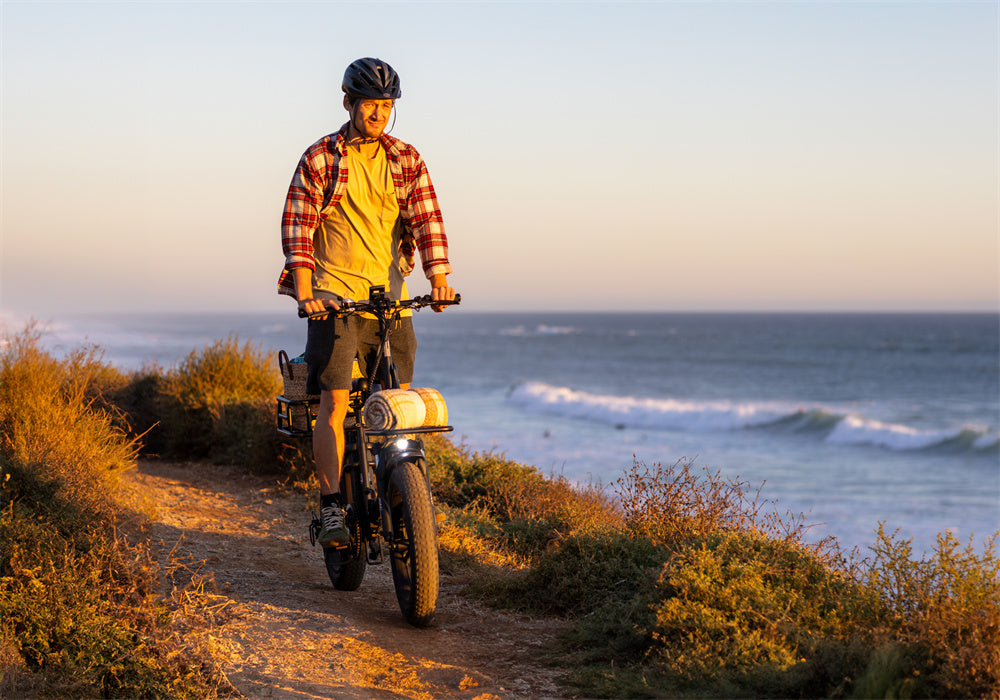Fat biking is an exciting form of outdoor cycling that has gained significant popularity among cycling enthusiasts and adventurers alike. This activity involves riding specially designed bicycles known as fat bikes, which are equipped with oversized tires typically ranging from 3.8 inches to 5 inches in width. Why Choose a fat tire electric bike? These large tires are the defining feature of fat bikes, allowing them to traverse diverse terrains that would be challenging or impossible for standard bicycles.
Fat biking originated in the late 1980s when cyclists in Alaska and the southwestern United States began experimenting with custom modifications to their bikes to allow riding on snow and sand. These modifications included wider frames and forks to accommodate larger tires, which provided better flotation on soft surfaces. Over the years, fat biking has evolved from a niche winter sport into a year-round activity enjoyed by cyclists around the world.

How Does Fat Tire E-bike Stand Out
Superior Traction
Fat tires provide exceptional traction, which is crucial for maintaining control and stability on diverse surfaces:

Stability and Control
The stability provided by fat tire bicycles makes them a popular choice for both novice and experienced cyclists:
-
Balanced weight distribution: The width of the tires ensures that the cyclist’s weight is evenly distributed, enhancing overall balance.
-
Smooth ride over bumps: Fat tires can easily roll over obstacles like roots and rocks, providing a smoother ride.
-
Lower center of gravity: The ability to use lower tire pressure results in a lower center of gravity, which improves bike handling.
-
Enhanced cornering ability: The stability of fat tires allows for more confident cornering at higher speeds.
- Reduced fatigue on long rides: Stability means less effort is required to control the bike, reducing rider fatigue.

Versatility Across Terrains
Fat tires adapt seamlessly to various types of terrain, making them ideal for adventurous riders:
Increased Comfort
The design of fat tires directly contributes to a more comfortable biking experience:
-
Shock absorption: The volume of air in fat tires allows them to absorb shocks from rough terrain, reducing stress on the rider’s body.
- Pressure customization: Riders can adjust tire pressure to suit the terrain and their comfort level, which is not possible with standard tires.
-
Reduced vibration: The tires dampen the vibrations caused by uneven terrain, leading to a smoother ride.
-
Less strain on joints: The smoother ride minimizes impact on joints, particularly on longer journeys.
- Enjoyable riding experience: Overall, the comfort features of fat tires make cycling a more enjoyable activity.

Durability and Longevity
Fat tires are built to last, offering excellent longevity and robustness:
How do fat tires ebikes work
These tires are much wider than those found on standard mountain or road bikes. Fat tires are a defining feature of fat bikes, a type of bicycle designed for extreme riding conditions.
Design and Construction of Fat Tires
-
Width and Volume: The most noticeable characteristic of fat tires is their width. This significant width increases the volume of air within the tire, allowing it to be used at much lower pressures than traditional bike tires.
-
Rubber Composition: Fat tires are made from a durable, flexible rubber compound that helps in gripping uneven and slippery surfaces. The rubber must be tough enough to withstand sharp objects and rough terrain without puncturing easily.
- Tread Patterns: The tread on fat tires can vary greatly depending on the intended use. Treads may be deep and widely spaced for muddy conditions or tightly packed for better rolling efficiency on hard-packed snow or sand.
Mechanics of Fat Tires
-
Low Pressure Advantage: One of the key advantages of fat tires is their ability to operate at lower pressures. Lower tire pressures allow the tires to deform more, increasing the contact area with the ground. This larger contact area improves traction by spreading the load over a broader surface, reducing the pressure on any single point and preventing the tire from sinking into soft ground.
- Flotation: In soft conditions such as snow or sand, flotation is critical. The wide footprint of fat tires distributes the weight of the bike and rider over a larger area, which prevents them from sinking into the surface, much like snowshoes.
- Shock Absorption: Fat tires act as natural shock absorbers. Their volume allows them to compress over bumps, smoothing out the ride in rough conditions. This reduces fatigue and increases comfort for the rider.

What Are The Disadvantages Of Fat Tire Ebikes
Fat tire bikes, while popular for their numerous advantages in various terrains and conditions, also come with some disadvantages that potential riders should consider.
Increased Weight
Fat tire bikes are generally heavier than traditional bicycles due to the larger and wider tires and the stronger frames required to support them. This increased weight can lead to several issues:
-
Reduced speed and agility: The additional weight makes fat tire bikes less nimble and slower on paved roads and flat terrains where lighter bikes would excel.
- Greater effort to pedal: The heaviness can also make pedaling more strenuous, especially on uphill climbs or during long-distance rides, potentially leading to quicker fatigue.
Higher Rolling Resistance
The same wide tires that provide excellent traction and stability also result in increased rolling resistance. This can affect the bike's overall efficiency in several ways:
-
More energy required: It takes more effort to maintain speed and momentum, particularly on smooth surfaces where the friction from wide tires can slow a rider down.
- Slower acceleration: Getting up to speed can require more time and energy, which might be frustrating for riders used to quicker, more responsive bikes.
Cost and Availability
-
Higher price point: Fat tire bikes typically come at a higher price due to the specialized materials and technology required to produce them. This can be a barrier for some potential buyers.
- Limited availability of replacements and upgrades: The parts and accessories specific to fat tire bikes, such as the tires themselves, are not as widely available as those for standard bikes. This can make maintenance and customization more difficult and expensive.
The Bottom Line
TESWAY really stands out in the crowded American electric bike market. They’re committed to quality, which means every bike they sell is top-notch. Whether you're commuting, going on an adventure, or just cruising around, TESWAY bikes provide a reliable and enjoyable ride every time.
FAQs
Can fat tire electric bikes be used on regular roads?
Yes, while fat tire electric bikes are optimized for rough and soft terrains, they can also be used on regular roads. However, due to their increased rolling resistance and weight, they may be slower and require more effort to pedal compared to standard road bikes.
How should I maintain my fat tire electric bike?
Maintenance for fat tire electric bikes involves regular checks and care similar to standard bikes but pay special attention to the tire pressure, battery maintenance, and the condition of the electric motor and its connections. Regular cleaning and lubrication of the bike's components are also essential to ensure longevity and optimal performance.







Share:
Electric cargo bikes that make it easier to carry your gear,easy to travel
How long do ebikes last—Here's What You Want To Know